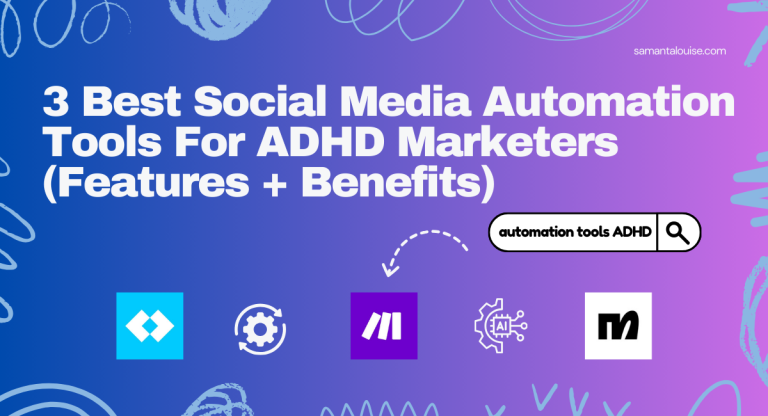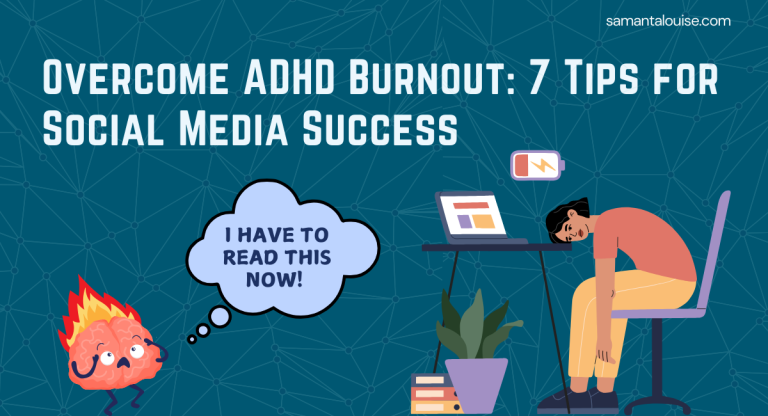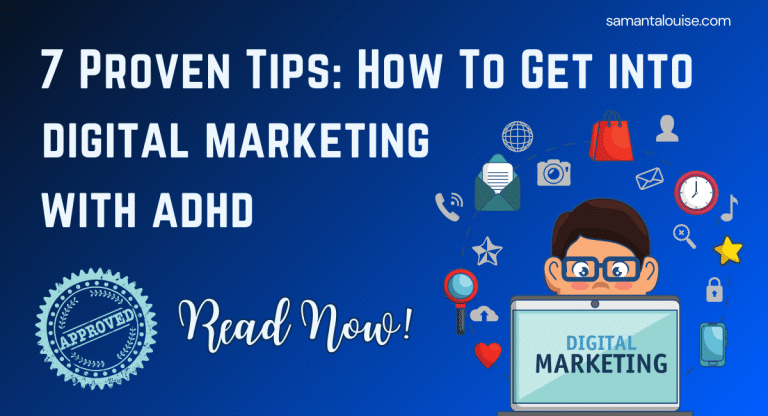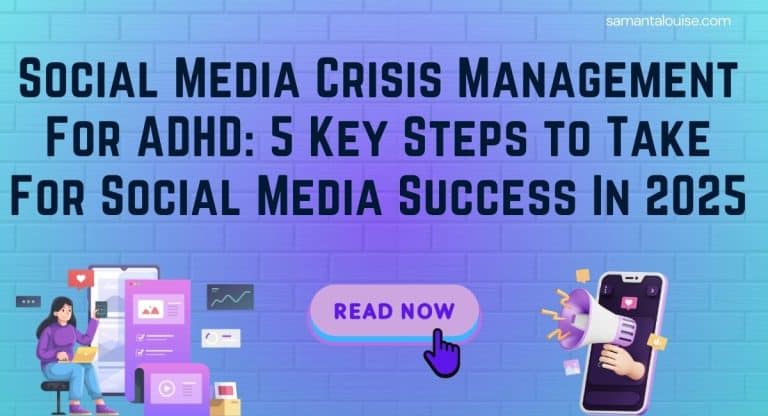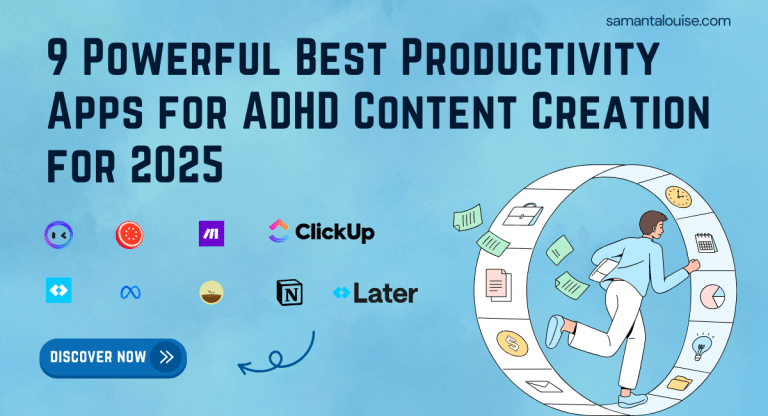Ultimate Guide: 5 Ways to Navigate the ADHD Iceberg in Digital Marketing Effectively (Complete Guide)
Looking backwards, I wish someone had told me sooner about the ADHD Iceberg before starting my digital marketing career. Being a digital marketer with ADHD can change the way you carry out your marketing duties, and even if it comes with some advantages, it can be tough to perform outstandingly if you become trapped in the vicious cycle of ADHD symptoms constantly ruining your efforts.
It becomes so much easier to overcome these challenges if you learn about the ADHD Iceberg: a visual way to learn about and understand the several challenges of having ADHD. This not only allows you to spot your weaknesses but also craft powerful strategies to help you navigate the digital marketing world more effectively by implementing ADHD-friendly solutions.
In this article, we are going to learn about the ADHD iceberg from a marketer’s lenses and explore adhd-friendly solutions to deal with our ADHD challenges more effectively. I will also share the best productivity tools I use that keep me on track and help me perform better in my daily life as a digital marketer!
What Is the ADHD Iceberg Model?
You know what really changed my perspective as a marketing professional? Understanding the ADHD iceberg theory. After years of struggling with my own marketing workflow optimization, I finally discovered why some of my challenges ran so much deeper than just missing deadlines or getting distracted during client calls.
Think of an iceberg floating in the ocean. What we see above water is just a tiny fraction of its actual size. That’s exactly how ADHD works in our marketing with ADHD traits – there’s so much more going on beneath the surface than most people realize.
Above the water, you’ll spot the obvious stuff. Maybe you’re the marketer who’s always juggling multiple browser tabs, or perhaps you’re known for those brilliant but somewhat scattered client presentations. These are the “tip of the iceberg” symptoms – the ones everybody sees and often misunderstands. But here’s where it gets interesting (and trust me, this changed everything about my approach to digital marketing ADHD). Below the waterline, there’s this whole complex world of invisible challenges that actually drive those surface-level behaviors!
Understanding these hidden aspects completely transformed my approach to marketing task management. Instead of beating myself up about missed deadlines or scattered focus, I started developing systems that worked with my brain, not against it.
Here’s the really cool part that most articles don’t tell you about – when you understand both the visible and invisible aspects of ADHD, you can actually start turning them into advantages in your marketing work. For instance, that same brain that struggles with traditional planning? It’s often incredible at spotting patterns in marketing data or coming up with creative marketing solutions during a crisis.
I remember when I first started implementing ADHD business systems based on this deeper understanding. It was like finally having a map after years of wandering in the dark. My marketing productivity tools started making sense because I was choosing them based on my actual needs, not just what worked for neurotypical marketers. The beauty of understanding this model isn’t just about identifying challenges – it’s about recognizing that these traits can become our superpowers in the marketing world. When we understand why we work the way we do, we can build marketing systems ADHD professionals actually benefit from.
This journey of understanding isn’t always smooth sailing. Some days, managing marketing task focus still feels IMPOSSIBLE. But knowing what’s really going on under the surface? That knowledge is absolutely game-changing for developing effective ADHD work strategies. Whether you are already a marketer or looking to start a career in marketing, you will benefit a lot from knowing about the ADHD iceberg and its impact on marketing efforts.
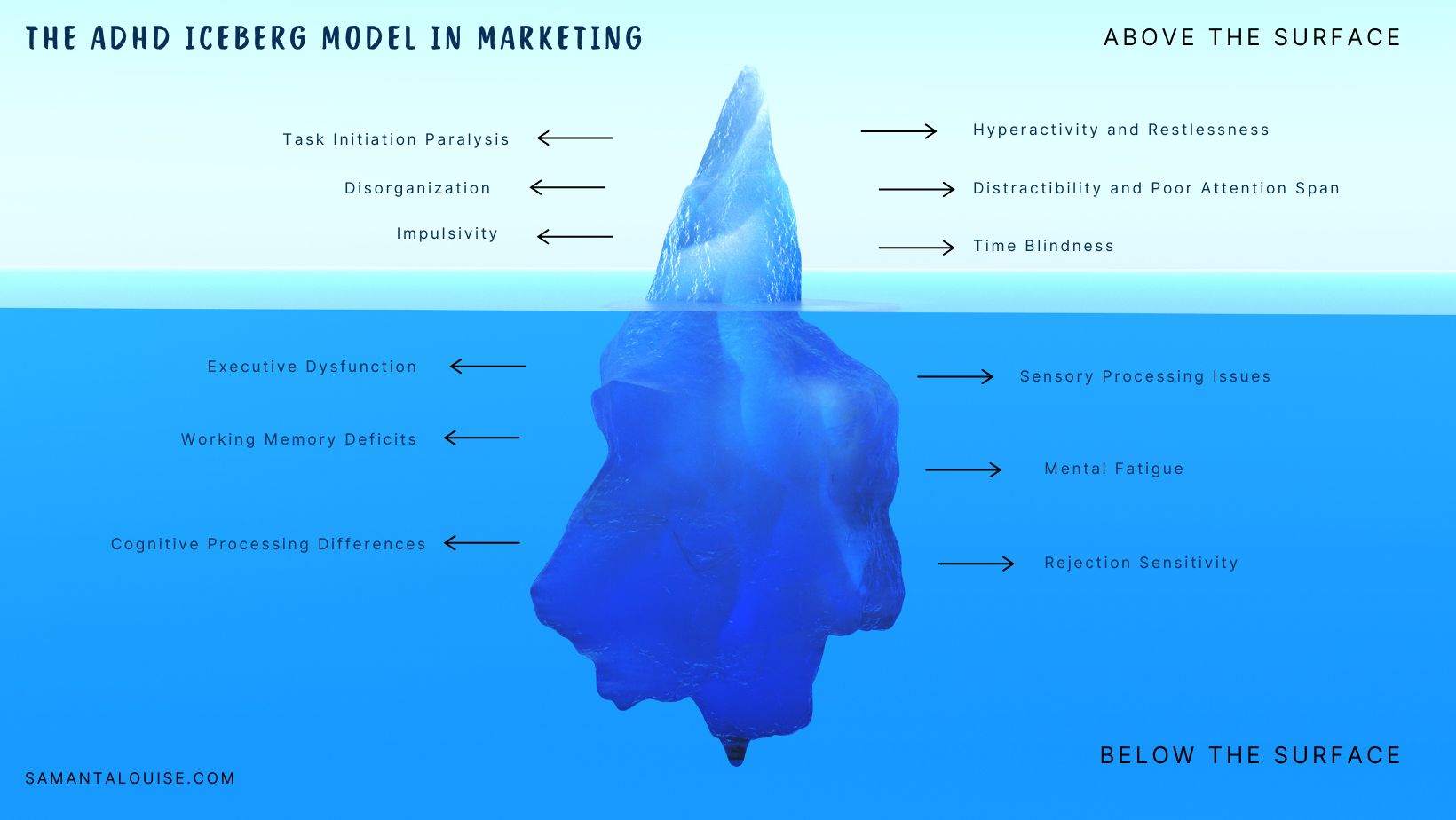
Above the Surface: Visible ADHD Symptoms in Marketing Work
As a marketer with ADHD, I’ve noticed how certain symptoms directly impact our professional performance. Let’s break down the most visible ADHD symptoms and understand their specific effects on marketing work. These are the symptoms that everybody sees, what everyone assumes when you have tell them you have ADHD. It is a good thing to be aware of these symptoms as they prepare you generally to face them.
1. Hyperactivity and Restlessness
That constant need to move, fidget, or feel physically unsettled? I have felt that multiple times and it is probably reason I cannot stick to my desk for more than 10 mins! When you work as a digital marketer, this manifests during crucial client presentations or long strategy meetings. Picture this: you’re trying to present a detailed campaign analysis, but you can’t stop moving, clicking your pen, or shifting in your chair. While this energy can be fantastic for creative brainstorming sessions, it can seriously impact how clients perceive your professionalism or how effectively you deliver important presentations. I’ve found myself losing track of key points mid-presentation simply because my body wouldn’t stay still.
2. Distractibility and Poor Attention Span
Forgetfulness and ADHD do not rhyme but many people tend to associate the two, and rightly so at times. The stereotype can be annoying from our perspective, especially when we are being compared to having the memory of a goldfish. When you are in marketing, this symptom hits particularly hard. When you’re managing multiple social media campaigns, each notification becomes a potential derailment. One minute you’re writing ad copy, the next you’re three hours deep into analyzing competitor websites that weren’t even part of your original task. his scattered attention affects our ability to maintain consistent marketing task focus, especially when working on less stimulating tasks.
3. Time blindness
This symptom is perhaps one of the most challenging for marketing professionals. We struggle to accurately estimate how long tasks will take, leading to missed deadlines and overcommitment. A “quick” social media update turns into a three-hour content creation session, while an “hour-long” client report stretches into an entire afternoon. This directly impacts our marketing workflow optimization and client relationships, as we consistently underestimate project timelines. We can find ourselves falling into a pit of doomscrolling.
4. Impulsivity
Being impulsive can mean many things and usually has a negative connotation and when you are a marketer with ADHD, it can mean making quick decisions without fully thinking through consequences. We might hit ‘publish’ on social media posts without proper review, make spontaneous changes to running campaigns, or commit to unrealistic client deadlines in the heat of the moment. While this quick-thinking can sometimes lead to brilliant creative marketing solutions, it can also result in costly mistakes that require damage control.
5. Disorganization
The visible chaos in our digital and physical workspaces directly affects our marketing task management. Multiple unfinished drafts, scattered campaign assets across different folders, and an inbox that looks like it’s been hit by a digital tornado – these are all hallmarks of ADHD disorganization in marketing work. This symptom makes it particularly challenging to maintain consistent brand guidelines and organize campaign materials effectively. And let’s not talk about the disorganized desk, should we?
6. Task Initiation Paralysis
This manifests as struggling to start important marketing tasks, especially those requiring detailed planning or systematic execution. Content calendars remain empty, email campaigns sit in draft mode, and analytics reports get postponed, not because we don’t know how to do them, but because initiating these tasks feels overwhelmingly complex. The good news is that ADHD paralysis can be overcome with the right strategies in place. There are 3 types of ADHD paralysis: task initiation, choice paralysis and mental paralysis.
Understanding these visible symptoms is crucial for developing effective ADHD work strategies. Each symptom in the ADHD iceberg presents unique challenges in our marketing work, but they also offer opportunities for developing specialized coping mechanisms and systems.
Below the Surface: Hidden ADHD Impact on Marketing Tasks
While visible symptoms like hyperactivity and distractibility are easily noticed, the ADHD iceberg reveals deeper challenges that significantly impact our marketing work. It is very important to learn and know about these symptoms that are not so visible but surely affect us on a daily basis. Let’s explore these hidden symptoms:
1. Executive dysfunction
This is probably our daily battle. It is the “invisible” force behind task management difficulties. It is the reason why you usually end up staring at your computer for two hours, unable to start crucial projects despite the looming deadline. You can find it hard to get started with a task even if you know exactly what needs to be done. You can also have problems deciding between options because you cannot prioritize them. These issues can build up over time and lead to ADHD burnout.
2. Working Memory Deficits
Picture trying to hold multiple pieces of information in your mind while working on a marketing campaign, it can feel like too much too handle at times. You might find yourself reading an email three times because by the time you reach the end, the beginning has already slipped away. It’s not about intelligence; it’s about how our brains temporarily store and manipulate information. That’s why we often have 47 browser tabs open (they’re our external memory!), and why we might ask a client to repeat something they just said – not because we weren’t listening, but because we are unable to process the information fast.
3. Cognitive Processing Differences
While others might follow a linear path from A to B, our minds create elaborate networks of connections, sometimes leading to brilliant insights and other times to complete derailment. You might start researching Facebook ad metrics and end up deep in an article about color psychology in marketing – two hours later, wondering how you got there. This non-linear thinking can be our superpower in creative tasks but can also make structured work feel draining and overwhelming.
4. Sensory Processing Issues
Ever feel overwhelmed by your open-office environment, or find yourself unable to focus because someone’s eating an apple three desks away? Welcome to the world of sensory processing in the ADHD brain. It’s like having a sound mixer where all the channels are set to maximum volume. Some of us cannot hear other people eat or making other noises. his isn’t just being “picky” or “sensitive”; it’s your brain’s unique way of processing environmental input, which can significantly impact your work performance.
5. Mental Fatigue
This goes beyond just feeling tired. It’s that bone-deep exhaustion after masking your ADHD symptoms in back-to-back meetings, or the mental fog that descends after hyperfocusing on a project for hours. Your brain works overtime to compensate for executive function challenges, making ordinary tasks require extraordinary effort. It’s like running your laptop with 50 programs open, eventually, it’s going to need a restart. This isn’t laziness; it’s your brain’s way of saying it needs to recalibrate after processing information differently from neurotypical brains.
6. Rejection Sensitivity
This is the hidden emotional undertow of ADHD that rarely makes it into the mainstream discussion. It’s why a client’s “constructive feedback” can feel like a personal attack, or why a lukewarm response to your campaign pitch can send you into a spiral of self-doubt. Rejection Sensitivity Dysphoria (RSD) makes us experience rejection – real or perceived – more intensely than others. It’s not being “too sensitive”; it’s a neurological response that makes emotional regulation particularly challenging in professional settings.
Understanding these hidden impacts is crucial for developing effective coping strategies. They’re not just challenges to overcome – they’re aspects of our neurodivergent marketing minds that require specific accommodations and systems.
The key is recognizing that these hidden impacts aren’t character flaws or professional shortcomings. They’re part of how our ADHD brains process and interact with marketing work, and acknowledging them is the first step toward developing effective management strategies.

Impact on Daily Marketing Operations
It took me a long time to figure this out but I am glad I did! Better late than never, right? Here it is: managing ADHD is difficult but it is not impossible and one more thing: you cannot cure your ADHD. If someone is telling you this, it is either a scam or they are clueless about this condition themselves. Trust me, I’ve been there, and I’ve got the metaphorical burn marks to prove it.
When it comes to marketing task management, sleep issues have been my biggest nemesis. There was this one time when I was working on a crucial client campaign, and my ADHD content creation brain decided that 2 AM was the perfect time to get into marketing hyperfocus mode. Sure, I created some amazing content, but I was practically a zombie the next day during an important client presentation. That’s when I realized I needed to develop better ADHD work strategies. Here’s what I’ve learned about managing daily operations with ADHD:
1. Your sleep pattern matters
I discovered that setting up a strict “content creation curfew” actually improved my digital productivity. No more late-night editing sessions! We are not usually not morning people, but it does not mean you should not sleep at night because it is bad for your health.
2. Know when to stop
My hypersensitivity to notifications was seriously messing with my ADHD social media strategy. Y’all won’t believe this, but I used to check analytics every hour! Talk about marketing workflow optimization gone wrong. Now, I’ve set up specific times for engagement and use marketing automation tools for the rest.
3. Invest in yourself
One of my biggest struggles was with self-esteem during client presentations. There was this one time when I completely blanked during a pitch because my executive function marketing skills decided to take a coffee break. Now I use tools and apps even if they are sometimes premium and I have to pay for them. As long as they help me perform better, it is fine.
4. Stop fighting against yourself
The most important thing I’ve learned? Don’t fight your ADHD traits – work with them. Some days, your marketing creativity will be off the charts, and other days, you’ll struggle with basic tasks. That’s okay! It’s about building systems that support your unique way of working. These challenges aren’t failures – they’re opportunities to develop better ADHD business systems.
Transforming Your ADHD Challenges into Marketing Solutions
Enough about talking solely about the challenges and problems of ADHD, let’s talk about the solutions. This is the big question – what can you do to make it better? What can you do to perform better and turn your challenges into ADHD strengths? The ADHD iceberg is not only about showing you the symptoms, it is also about helping finding solutions.
After years of beating myself up about my ADHD traits, I discovered that these challenges could actually become powerful advantages with the right approach. By developing ADHD-friendly systems , I’ve found ways to not just cope, but thrive in the marketing world. The key is understanding that success doesn’t mean forcing ourselves to work like neurotypical marketers, but rather creating systems that work with our unique brain wiring.
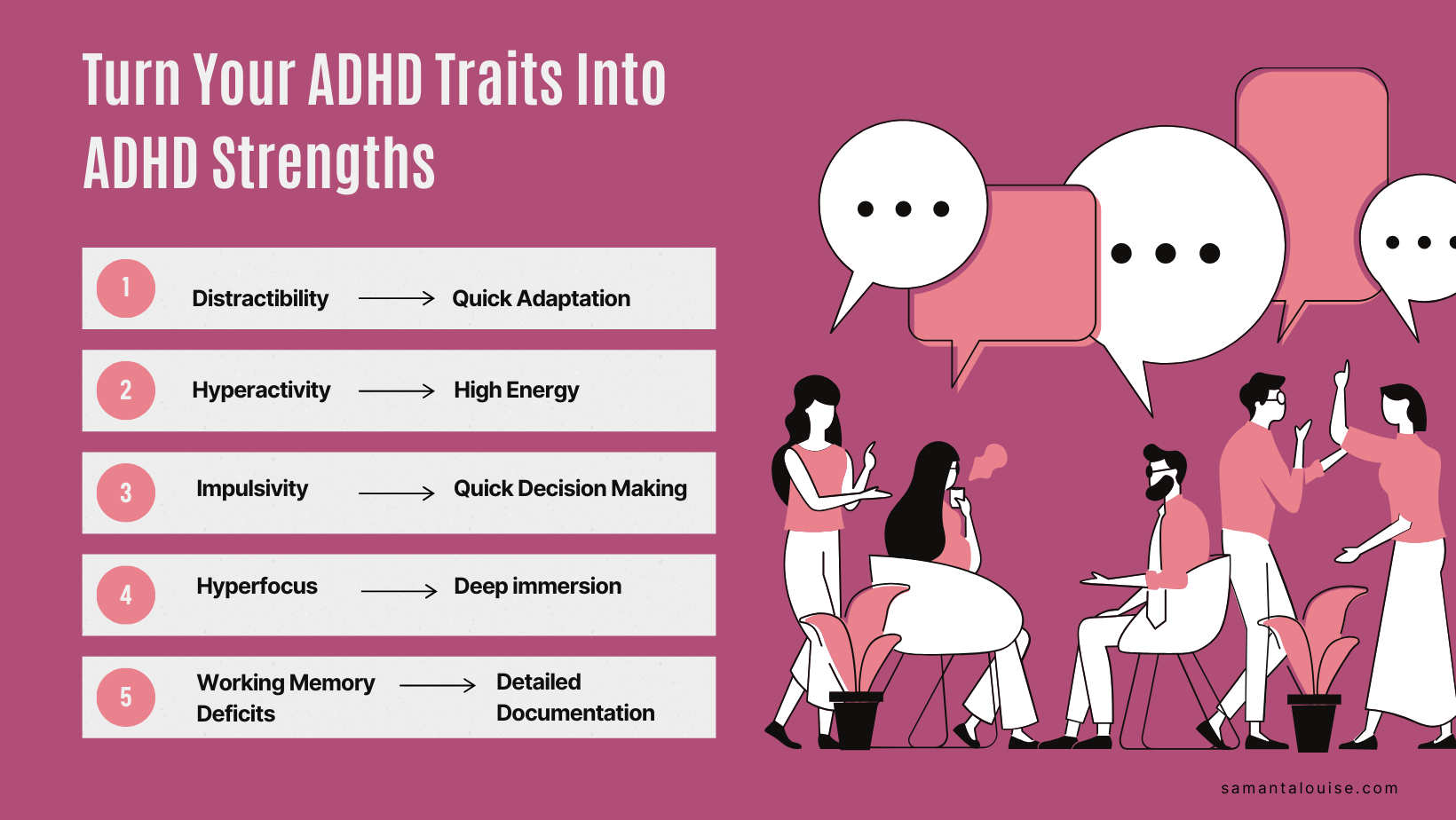
Practical Ways To Overcome ADHD Challenges In Marketing
Turning your ADHD challenges into your strengths is not just some mental thing. You need to take action by implementing the right strategies in your daily life. Let’s explore together what I have done over the years to make this possible:
1. Use Systems and Tools
It is not a shame to use tools to help you out. I use them all the time and having systems that facilitate the use of these tools help tremendously. For example, I use social media automation tools for my campaigns. In terms of systems, I do a lot of content batching to help me create content during my high energy hours. Here are some actionable tips for success:
- Use Trello with color-coding for different project stages (I use red for urgent, yellow for in-progress, green for completed)
- Set up automated reminders 48 hours AND 24 hours before deadlines (because one reminder isn’t enough – ask me how I know!)
- Break down projects into 25-minute chunks using the Pomodoro technique
- Use voice notes for capturing ideas (game-changer for those random 3 AM inspirations)
2. Manage Your Emotions Through Effective Strategies
Sometimes, we can feel low and demotivated very easily so it is important to manage these emotions effectively. Here is what I usually do to prevent myself from hitting rock bottom when it comes to my negative emotions:
- Create a 24-hour “cooling off” rule for responding to challenging feedback
- Use templates for common client communications to maintain professional tone
- Keep a “wins folder” to review before difficult meetings (helps with confidence!)
- Practice the “STOP” method: Stop, Take a step back, Observe, Proceed
3. Use Time Management Techniques
Time management is not our forte and this can affect our professional lives but with some changes to your routines, you can manage your time more effectively. My ADHD content creation process used to be chaos until I implemented these systems:
- Block schedule content creation in 90-minute focused sessions
- Use the Pomodoro Technique to remain focused
- Create content batches during peak energy hours (for me, that’s 10 AM – 1 PM)
- Set up a simple content calendar with flexible deadlines
The key to making these strategies work is customization. I’ve tweaked each one through trial and error to match my specific challenges. These aren’t just productivity hacks – they’re survival tools for thriving in marketing with ADHD.

